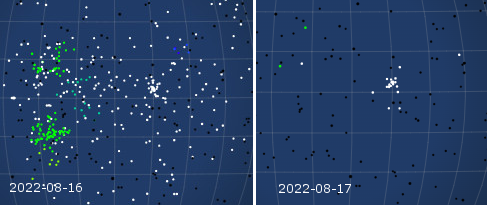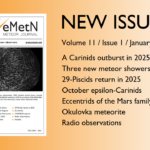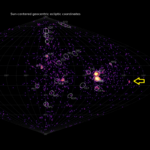Abstract: On August 16, 2022, the global CAMS low-light video camera networks detected a meteor outburst in the anti-helion source from a median radiant at geocentric position R.A. = 324.7 ± 0.2°, Decl. = -11.6 ± 0.3°, with geocentric speed vg = 24.2 ± 0.3 km/s (Equinox J2000). The parent comet of this meteor shower is now identified as 45P/Honda-Mrkos-Pajdusakova. The shower previously associated with this comet from D-criterion searches among photographed orbits is IAU number 199, called the August delta Capricornids. The observations suggest that Earth crossed two dust trails, one trail being ejecta from the 1980 return of 45P.
Introduction
After a strong detection on August 17, 2022 (Jenniskens, 2022a), the new shower on the border of Aquarius and Capricorn was no longer detected on August 18 (see CAMS website for the date of 2022 August 18 and the report in Jenniskens, 2022b). Sekiguchi (2022) pointed out that the longitude of perihelion of these meteoroid orbits, not just the shape of the orbit, agreed with that of comet 45P/Honda-Mrkos-Pajdusakova.
Observations
The following CAMS networks contributed to this report: 82 meteors were triangulated by CAMS Namibia (coordinated by T. Hanke), 11 by CAMS Chile (S. Heathcote, E. Jehin), 9 by LO-CAMS (N. Moskovitz), 9 by CAMS BeNeLux (C. Johannink), 7 by CAMS California (station operators T. Beck, J. Albers, E. Egland, and B. Grigsby), 5 by CAMS Florida (A. Howell), 5 by CAMS South Africa (T. Cooper), 4 by CAMS Arkansas (L. Juneau), 3 by CAMS Texas (W. Cooney) and 1 by the UAE Astronomical Camera Network (M. Odeh).
In all, 137 meteors were triangulated by the global CAMS networks, concentrated mainly during two brief time intervals. The first peak was centered on solar longitude 143.16 ± 0.02 deg (33 orbits), while the second stronger peak was centered on solar longitude 143.707 ± 0.008 deg (equinox J2000.0), corresponding to 2022 Aug. 16 22h00m UTC (98 orbits). Six meteors were detected outside these intervals.
Table 1. Median orbital elements of the shower 199 outburst in 2022.
| a | 3.16 AU | |
| q | 0.547 ± 0.025 AU | |
| e | 0.823 ± 0.069 | |
| i | 1.90 ± 1.30° | |
| ω | 270.7 ± 2.3° | |
| Ω | 143.2 ± 0.7° | |
| N | 137 |

Figure 1 – The radiants as spotted in two different nights. From Jenniskens (2022a).
Discussion
That second outburst was predicted. Maslov predicted an encounter with the 1980 dust of 45P on 2022 Aug. 16 around 23:40 UTC and put the radiant at R.A. = 326.8 deg, Decl. = -15.1 deg. The observed coordinates for the second peak were R.A. = 325.28 ± 0.06, Decl. = -11.40 ± 0.06 with Vg = 24.12 ± 0.14 km/s. According to these calculations, Earth passed only 0.0038 AU from the center of the dust trail and encountered dust that was ejected at a modest speed of 9.8 m/s. To my knowledge, this is the first time an encounter with a dust trail of 45P has been confirmed.
A shower with similar radiant and speed is already listed in the IAU Working List of Meteor Showers as number 199, called the August delta Capricornids. That makes the name 18-Aquariids (Jenniskens, 2022a) a duplicate.
A difference in the orientation of the nodal line between the current comet orbit of 45P and the meteor shower assigns these as dissimilar using the usual D-criteria. That rotation of the nodal line is mostly a consequence of a close encounter of the comet with Jupiter in 1983. The observed meteoroids were ejected in the orbit prior to this encounter.
References
Jenniskens P. (2022a). “18-Aquariid meteor shower 2022”. CBET 5159, published 2022, August 17. Ed.: D. W. E. Green. Cambridge: Central Bureau for Astronomical Telegrams.
Jenniskens P. (2022b). “CBET 5161: August delta Capricornids meteor shower. CBET 5161. Ed.: D. W. E. Green. Cambridge: Central Bureau for Astronomical Telegrams.
Sekiguchi T. (2022). “New radiant on Aquarius/Capricorn border by the SonotaCo network”. eMeteorNews, post of 2022 August 18.




